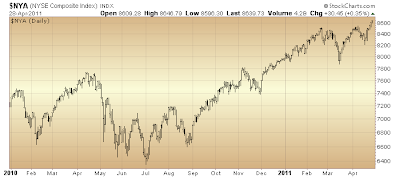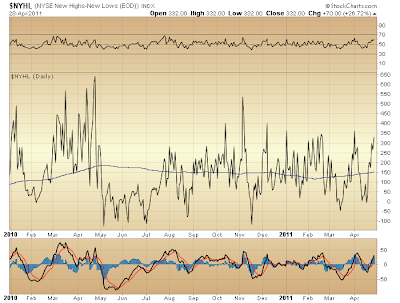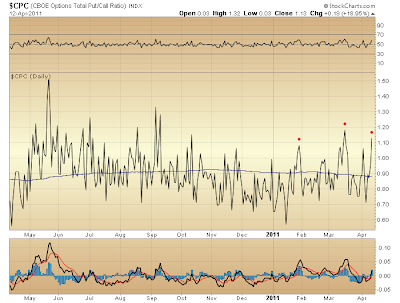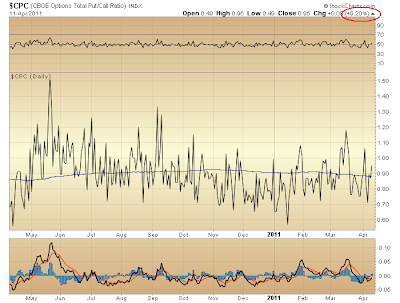This week's lift raises probability that, the market's counter-trend rally off March '09 bottom is not yet complete. Still, with an extraordinarily poor technical backdrop accompanying the market's continuing levitation there really is little else to say than, oh, that tricky Fed. In other words, only
fools are being deceived.
Sure, creating technical demand for financial assets has been one consequence of the Fed's liquidity backstop whose provision substitutes for credit no longer forthcoming from a [collapsed] shadow banking system. However, this provision cannot last. Absent that bottomless pit of "valuable" securities possessing AAA ratings assigned by partners in fraud among bond rating agencies — criminals still on the loose,
aiding and abetting cohorts in Congress — the Fed's gusher increasingly must go into highly liquid and leverageable "things" (commodities), as well as the safest securities (Treasuries). Such is the consequence of collapsed confidence in Adam Smith's leveraged Ponzi scheme.
More critically, with honest admission that, Team Fraud is pushing on a string, one is left with possibility that, financial matters these days play second fiddle to a much more insidious end. To wit, with unprecedented institutional aid given to
fascists among the trans-Atlantic community largely poising to cement a decades-long drive to consolidate physical capacity, while at the same time standing largely depleted, if not destroyed, is investment facilitating creativity essential to ensuring robust economic growth (think infrastructure of every sort: both material and human), one might reasonably conclude that, nearer is a moment when overthrow of the great republican experiment begun in 1776 becomes an increasing risk. Naturally, no one thinks in these terms, yet are not institutions allowing profound fraud to become the "new normal" tempting their own destruction, standing prostrate to the Frankenstein they created? Might not their usefulness likely be approaching its "best if used by" date, considering Standard & Poor's threat this week thinly disguised as a credible(!) warning? Again, this argument hinges on honest admission that, Team Fraud and its Fed are pushing on a string.

One might find objectionable the above Elliott wave count applied to the market's 5-wave advance off late-June 2010 bottom. However, beyond the fact that no Elliott Wave Principle rules are violated, there are a couple good reasons for accepting this wave count's validity.
First has been a well-established tendency since March '09 bottom for second and fourth wave alternation to develop in precisely the fashion seen above. When one corrective wave has unfolded with a sideways-to-down bias, the other has unfolded with an upward bias. You might recall this dynamic being noted here many moons ago (late-2009, early-2010-ish). It really comes as little surprise, then, this unique manner of alternation should persist over the entire duration of the market's counter-trend rally since March '09.
Recently noted, too, is the manner in which relative strength (top panel) confirms the component waves of wave
4, as well as how increasing technical weakness typical in formation of a fourth wave (versus its preceding second wave) indeed registered as wave
e of
4 unfolded.
Next, consider the technical backdrop accompanying the market's advance off late-June 2010 bottom — a configuration that, only until recently was seen justifying the case for a "rising wedge" forming into February 18th top. The transition to the above wave count in fact is no great leap in the realm of possibility giving form to the final leg of a counter-trend rally in
a market vanquished of animal spirits...

Over the course of the market's 5-wave advance since late-June 2010 the worst reading on the NYSE 52-week high-low differential still accompanies wave
4 — in the revised wave count, specifically, wave
c of
4 (November 2010).
Just as was the case when a "rising wedge" was thought unfolding off late-June 2010 bottom (in forming wave
(c) of an a-b-c corrective wave up from March '09), the technical backdrop accompanying formation of wave
4 of
(c) in the revised view above still reveals deterioration — increasing technical weakness — in relation to wave
2 of
(c) (August 2010). This, of course, is typical.
Interestingly enough, too, during formation of both corrective waves (i.e. waves
2 and
4) the worst reading on the NYSE 52-week high-low differential was registered during formation of wave
c (a "c" wave being an Elliott corrective wave's third wave, which typically is the most dynamic Elliott wave).
No doubt, the NYSE 52-week high-low differential since late-November 2010 certainly reveals just how lame has been the effect of the Fed's liquidity gusher. Despite major indexes moving into new high ground, post-March '09 bottom, early in December, 2010, the love driving the market's lift has been directed toward a diminishing number of issues. Thus, too, is the full measure of complacency underlying the market's advance revealed, as laggards are held rather than increasingly dumped (as wisdom born of a technical backdrop whose weakness grows otherwise advises they should be).
The revised fourth wave's upward bias notwithstanding, the technical backdrop revealed by the NYSE 52-week high-low differential both substantiates the revised wave count since late-June 2010 bottom, as well as lends caution toward what further advance might lie in store as wave
5 of
(c) unfolds. It stands to reason that, thinning leadership might be putting in a rather low ceiling on what advance still remains before the market's counter-trend rally off March '09 bottom at last is completed.
This week's mixed results (per indexes reaching new counter-trend rally highs) suggests the market's levitation likely will persist over weeks ahead. Nevertheless, no matter what form wave
5 of
(c) takes, the year 2011 still is poised to become the worst in the recorded history of the stock market. The Fed is pushing on a string, allowing a bull trap to be built by its fascist protagonists, that radical consolidation of material wealth might be most rapidly achieved. Thus, the most relevant question an investor must answer is whether there can be a bull market in the riskiest financial asset of all in the face of conditions conducive to creation of a huge pool of slave labor? Because that's where we are heading if
Glass-Steagall is not immediately restored...

* * * * *
© The Risk Averse Alert — Advocating a patient, disciplined approach to stock market investing. Overriding objective is limiting financial risk. Minimizing investment capital loss is a priority.
Analysis centers on the stock market's path of least resistance. Long-term, this drives a simple strategy for safely investing a 401(k) for maximum profit. Intermediate-term, investing with stock index tracking-ETFs (both their long and short varieties) is advanced. Short-term, stock index options occasionally offer extraordinary profit opportunities when the stock market is moving along its projected path.
Nothing is set in stone. Nor is the stock market's path of least resistance always known. More often than not, there are no stock index option positions recommended. There's an easy way to boost your investment discipline...
There's an easy way to boost your investment discipline...
Get Real-Time Trade Notification!

 There's an easy way to boost your investment discipline...
There's an easy way to boost your investment discipline...






































